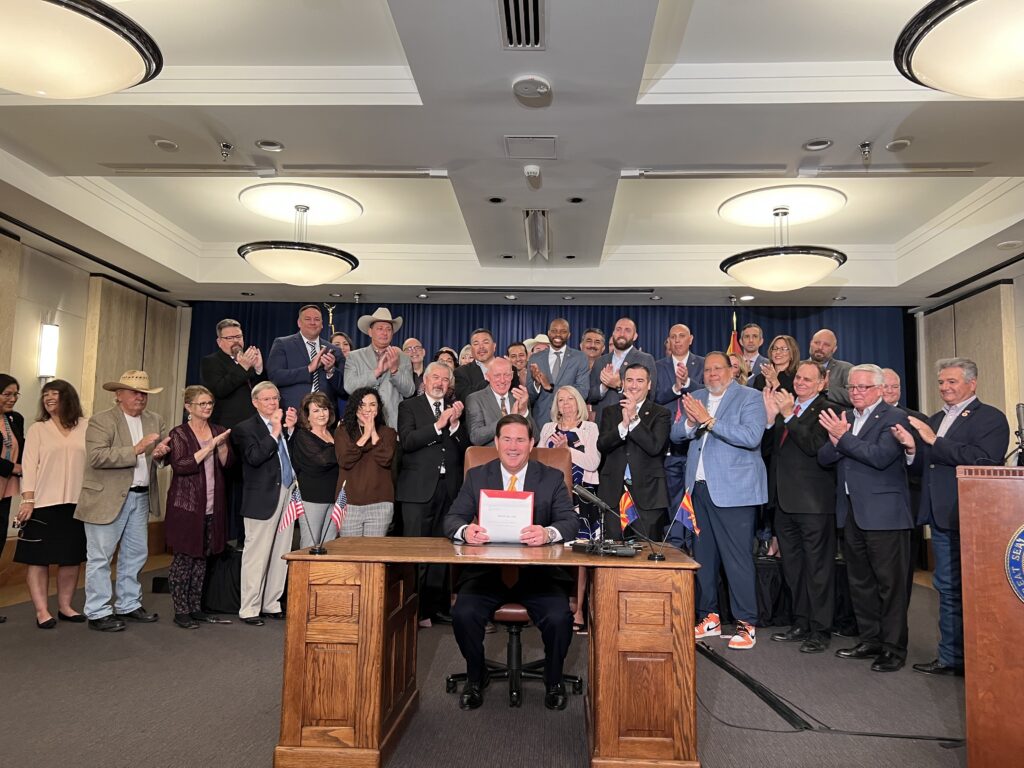
Governor Ducey Delivers On Promise to “Finish The Job” To Expand I-10

PHOENIX — Commuters, vacationers and commerce will see a smoother drive between Phoenix and Tucson, as Arizona invests $400 million to widen Interstate 10, delivering on a promise by Governor Doug Ducey in this year’s State of the State Address.
“In the State of the State, we promised that we would invest more dollars to get the I-10 completion leap-frogged to the front of the priority list. Today, we’re delivering on that promise,” said Governor Ducey at a signing ceremony. “This legislation ensures that everyone in Arizona can get to their destination safely and quickly, even as our state continues to grow. We’re not going to have the endless traffic jams you see in cities like Los Angeles, where men and women are stuck in their cars for hours every day.”
Known as the Wild Horse Pass Corridor, the segment between Chandler and Casa Grande is the last remaining stretch of highway between Arizona’s two largest cities that has only two lanes. The investment allocated by Senate Bill 1239, which passed with strong bipartisan support, will accelerate a proposed project to widen this congested 26-mile segment of I-10 from two lanes to three.
“I-10 between Phoenix and Tucson is a major artery for our state’s residents and commerce,” said Sen. T.J. Shope of Coolidge, who sponsored the bill. “Many Casa Grande and Coolidge residents use I-10 to commute to Phoenix for work. This expansion alleviates the pressure on our commuters and our businesses. I was elated when Governor Ducey committed in January to prioritizing this project and I’m glad he’ll deliver on that promise.”
The up-front investment would competitively position Arizona to receive additional federal funds to complete the project. Total cost of the project is estimated to be just under $1 billion, with nearly $700 million in state-dedicated funding.
“With the passage and signing of S.B. 1239 Arizona has shown its commitment to providing the safest, most reliable transportation system in the nation,” said Gila River Indian Community Governor Stephen Roe Lewis. “The I-10 is an important economic corridor and with its widening will expand investment and generate additional economic activities within my tribal community, the state and the region.”
With businesses and new residents flocking to the state, the proposed highway expansion comes at a crucial time to relieve the current pressure, improve public safety and accelerate future growth in the area.
“Any commuter who travels on this part of I-10 will tell you it’s crowded and frustrating. Think about the bottleneck that creates for commerce,” said Casa Grande Mayor Craig McFarland. “Now, by expanding the highway, we’re opening new opportunities for enhanced trade and economic growth in Casa Grande. Thank you to Governor Ducey, Sen. Shope, Governor Lewis and the Arizona legislature for investing in our infrastructure.”
“The expansion of I-10 will open more opportunities for our residents and further economic growth,” said Chandler Mayor Kevin Hartke. “Supply chains will be more efficient, residents will have an easier commute and public safety will be increased. Thank you to Governor Ducey and the legislature for your leadership on this solution.”
The Wild Horse Pass Corridor links freight traffic from the international ports of southern Arizona and the West Coast to the rest of the nation.
“I-10 is a critical means of trade among Arizona, our surrounding states and Mexico,” said Tony Bradley, president of the Arizona Trucking Association. “A modern, efficient highway system is needed to get goods and products where they need to be on time. This expansion will allow trade and commerce to grow as Arizona’s economy grows. We’re grateful for the leadership of Governor Ducey for getting the job done.”
In addition to widening to three lanes, the proposed project will extend the High Occupancy Vehicle lanes in the northern portion, replace the Gila River Bridge, add and improve interchanges for enhanced mobility, and more.
The project is expected to start in 2023, with bridges that carry traffic over the Gila River. Target completion is 2026.
The improvements are anticipated to reduce the number of crashes in the corridor by half, according to the Arizona Department of Transportation, compared to predicted levels without expanding the highway.
BACKGROUND
Governor Ducey has prioritized improvements in infrastructure throughout his administration. From roadways to broadband, Arizona’s modernized infrastructure supports economic growth, Arizona families and education.
On Feb. 18, 2022, Governor Ducey announced an investment of $68.1 million to expand broadband connectivity along Interstate 40 West from Flagstaff to the California border. The expansion sustains the momentum of the Statewide Middle-Mile Network, which is currently underway adding connectivity along I-17 and I-19.
In February 2021, Governor Ducey announced $230 million in new transportation infrastructure investments including closing the funding gap to replace the Gila River Bridge on I-10, widening U.S. Route 93 north of Wickenburg, adding capacity to I-17 north of metro Phoenix and improving more than 600 highway lane-miles across the state.
The Governor’s fiscal year 2020 budget invested $130 million to widen I-17 to three lanes along 15 miles between Anthem and Black Canyon City. The funding will also build an 8-mile system of flex lanes on the grade between Black Canyon City and Sunset Point.
In 2019, the Loop 202 South Mountain Freeway in Phoenix opened, marking the culmination of the largest single freeway project in state history. The project finished three years early and with $100 million in savings through an innovative partnership.



